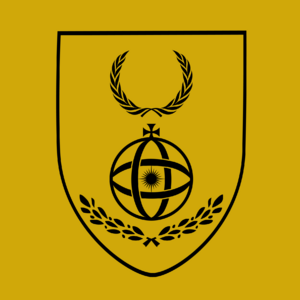President of the Patrajan Confederal Peoples Congress
This article is considered abandoned lore either because its creator has changed projects or has left the community. Accordingly, it is not only non-canon but it is also eligible for salvage pending approval from an administrator.
|
The Presidency of the Patrajan Confederal Peoples Congress was an executive-of-government position, last held by President Marija Marcella Torenvoa. It was the junior executive position of the Greater Patrajan Presidential Dual-Executive, a concept invented by political theorist Martin Torzhmann in 1995 during the redrafting of the Constitution of Patraja, merging the Head of State and Head of Government to become two positions occupied by one elected individual, enabling easier oversight, insight, and prosecution into the executive of the nation of Patraja. Since 2018, the Greater Patrajan Presidential Dual-Executive has been able to be voluntarily separated by the holder of the Presidency of Patraja, to alleviate presidential pressures and to grant head-of-government privileges to an Appointed Deputy-President of the Confederal Peoples Congress. Currently, the Appointed Deputy-President is Vladimir Krasimi Tovani, and is the de-facto head of the Patrajan Congress.
History
Initial Theory
The Presidency of the Patrajan Confederal Peoples Congress was reformed from the Prime Ministership of the Patrajan Federal Parliament on March 11th, 1995, upon the adoption of the Confederal Constitution of Patraja. The concept of the Greater Patrajan Presidential Dual-Executive was theorized about before 1995, primarily by political theorist, essayist and speaker Martin Torzhmann and his politico-philosophical movement of Governmental Devolutionists. The base concept was introduced in his essay, "Delineating Power from the Executive through Oversight without lacking Presidential Executive Authority," published in 1989 as a think-piece on devolving the title of Presidency to multiple, even dozens, of individual roles typically associated with an executive, all held by one person, but bureaucratically allowing for more oversight and more observation on the executive. In his 1990 follow-up essay, "Torzhmann's Republic of the Freed Executive," Torzhmann further elaborated that each of those positions could perhaps be separately taken, or impeached, from the President upon individual evidence of incompetence. Privately, he even believed that the executive should be allowed to voluntarily "give away" what he called Executive Responsibility Positions to create a complex executively-contained system of inter-presidential system. In 1992, during what scholars believe to be Torzhmann's "peak devolutionary years," he even believed that the Presidency should be a title of constant competition between holders of Executive Responsibility Positions, to create an isolated, responsible, and meritocratic system of competitive competence. During this time, he crafted his 24 Positions of the Executive. In late 1994, Martin Torzhmann was invited by the Federal Republican Government to help draft a new constitution for Patraja.
1994-1995 Drafting Period and Revisions
Over 70 delegates, including Martin Torzhmann, and an estimated 312 staffers, were responsible for the drafting of the Confederal Constitution of Patraja. Torzhmann's devolutionary ideals were highly present in the first draft of the Presidential Quarter of the Constitution, but were toned down severely in the second, third, and the final fourth draft. The Presidency underwent a severe revision period between the second and third draft, being transformed from, first, a weak and delineated executive, and then from a stronger, almost presidentially-republican executive, towards a balance of both. Torzhmann's ideals were kept in place using the Head of State/Head of Government system first proposed by delegate, Professor of Economics at the Patraja University of Economic Studies, and future President, Leonid Analli. For the Head of Government, a specific decision was made to rank it as junior to the Head of State, possibly for future clarification in courts when supposedly-eventual dissolution of the Presidency as it was drafted at the time was set up. The Delegation of 70, as it was known, was notably cynical about the Torzhmann ideals for the executive office, and were, by the end of the drafting period, openly talking of eventual redraws of the constitution to "fix the fickle issues of a deranged philosophy student," as Professor Markin Totravki, delegate at the draft.
Public Response
The public was largely ambivalent, or confused, about the role of the President upon the reveal and eventual institution of the Confederal Constitution. Most assumed that, by default, the new republic would have a single President in charge of both state and government representation, and notable few (37%, according to a Patraja Times poll taken in 2014) are aware of the distinction between the Presidency of the Confederal Peoples Congress and its sister-executive position, the Presidency of Patraja.
Abolition
The title of the Presidency of the Confederal Peoples Congress was abolished in 2028 upon the adoption of the Social Republic constitution, and all its powers as the head of governance was essentially transferred to the new Consul of the Senatorium.
